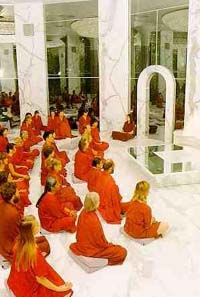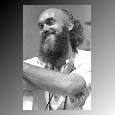
Biography
Born to a Jain family in Madhya Pradesh in 1931, Rajneesh Chundra Mohan is said to have attained enlightenment at the age of twenty-one without subscribing to any particular religious faith. Soon after, he received his MA in philosophy from the University of Sanjar and taught philosophy for the next nine years. While teaching at the University of Jabalpur in Bombay, Rajneesh also worked part-time as a religious leader. In 1960 he began to lecture publicly, directing his attention to India's need to advance technologically. During the early stages of his movement Rajneesh also lectured about the "primal energy of sex." Lectures on topics such as these, delivered with Rajneesh's abundant charisma, attracted a group of wealthy Bombay businessmen. In 1971, he changed his name to Bhagwan Shree Rajneesh, implying his spiritual achievement as a "Blessed Master." In 1974, Rajneesh left his position at the University of Jabalpur to dedicate himself entirely to his students (called sannyasins) at his newly established ashram in Pune, India. However, eventually his movement was faced with opposition in India. From Pune, Rajneesh fled to the United States (supposedly for medical reasons). A 6,500-acre plot of land near
Antelope, Oregon, was transformed into his new ashram in 1981. But soon controversy arose concerning the operations of this ashram (known as Rajneeshpuram) and Rajneesh was denied permanent residency status in the
United States. After several encounters with the law Rajneesh returned to his ashram in Pune, India, in 1987. However, he continued to face opposition everywhere he went. In his later years, Rajneesh changed his name for the second time to Osho (referring to an "oceanic experience," a term coined by philosopher William James). On January 19, 1990, Osho died of heart failure but there is speculation that he might have died of AIDs, or even poisoning by the CIA.
 Beliefs and
Teachings
Beliefs and
Teachings
The Rajneesh movement underwent several changes in its teachings of
modern monism from its inception in the 1960s to its decline in the 1980s.
During the late 1960s, Rajneesh communicated his radical message through
sensitive topics such as sex. He encouraged sexual expression through free
love and protested the conventional view of sex as taboo. Accordingly,
early ashram life (in Pune) began with experiments in sexuality and consciousness.
In 1979, Rajneesh announced his movement's goal to preserve mankind from
devastation through an eclectic religious, philosophical and spiritual
teaching. He combined elements of Hinduism, Zen Buddhism, Jainism, Taoism,
Christianity, Greek philosophy and new forms of therapy and meditation.
Rajneesh also developed a new form of meditation known as Dynamic
Meditation, characterized by physical activity
followed by silent meditation.
He explained that the family institution is outdated in the modern era,
and suggested its replacement by "alternative forms of community." Additionally,
Rajneesh believed that "national, gender, and racial divisions are destructive."
After his decline in Oregon, Rajneesh announced that AIDS would terrorize
the earth but that residents of
Rajneeshpuram would be saved through preventative measures. For more
information on teaching, see OshoTalks.
Controversies
Often referred to as the sex guru, Rajneesh and his movement encountered
opposition and speculation for their practices from conservatives worldwide.
Before his departure from India, a Hindu fundamentalist attacked Rajneesh
in 1980. Later, tumult arose when residents of Antelope, Oregon, expressed
their opposition to the movement. The 6,500-acre ashram in Oregon housed
3,000 residents, and included a 4,500 foot paved airstrip and a 44-acre
reservoir. To a community previously housing only 40 residents, Antelope
became a battleground for radical and conservative ideas to clash. Such
tensions eventually led the Rajneesh movement to court. However, within
a few years Rajneeshees ran the city council and renamed the city "Rajneeshpuram"
(City of Rajneesh).
Suspected drugging and poisoning by the group gave them even worse
publicity. At a time when new religious movements were established worldwide,
authorities feared an event such as the Jonestown fallout could reoccur.
Rajneesh was charged with the attempted murder of his doctor, and with
giving false information on immigration papers. He was deported to India
in 1987.
Financial issues also sparked controversy over the movement. During the early years commune life was characterized by spiritual and sexual experimentation. However, during later years much energy was diverted to raising money. Rajneesh's luxurious living also came into question. He is said to have been given 27 Rolls Royces by his followers.
Worldwide Presence
Early followers of Rajneesh were mostly young, educated Europeans and
affluent Indians. Small gatherings were held at Rajneesh's Bombay apartment.
The Pune ashram attracted about 50,000 Westerners seeking enlightenment,
and housed 600 permanent sannyasins. Rajneeshpuram housed 3,000 residents,
and attracted even more. At its peak, the Rajneesh movement had 200,000
followers and 600 centers worldwide. Followers were
encouraged by Rajneesh to set up centers in their home countries. Currently
there are 20 meditation centers worldwide, administered by 21 chosen followers.
References:
Skane, Elizabeth. Osho (or Rajneeshism). The University of Virginia,
Spring 1999. http://religiousmovements.lib.virginia.edu/nrms/rajneesh.html
Robinson, B.A. OSHO®, FORMERLY KNOWN AS BHAGWAN SHREE RAJNEESH.
Ontario Consultants on Religious Tolerance, 1997. http://www.religioustolerance.org/rajneesh.htm.
Links related to Bhagawan Shree Rajneesh

 Baba Ram Dass'
Baba Ram Dass' 
